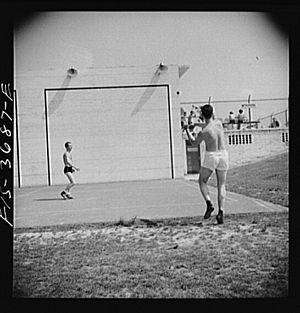American handball facts for kids

American handball is a super fun sport where players use their hands to hit a small rubber ball against a wall. The goal is to hit the ball so your opponent can't hit it back before it bounces twice. There are three main ways to play: against one wall, three walls, or four walls. You can play with two players (called singles), three players (cutthroat), or four players (doubles). It's a fast-paced game that's great for getting exercise!
Contents
The History of Handball Games
Games where people hit or throw a ball have been around for a very long time! We can find mentions of them even in ancient times, like in stories from Homer or in ancient Egypt. There was a game similar to handball played by people in North and Central America as far back as 1500 BC. The Aztecs were famous for playing their own version, called the Mesoamerican ball game.
The first time someone wrote about hitting a ball against a wall with a hand was in Scotland in 1427. King James I even had a window in his palace blocked up because it was getting in the way of his game! In Ireland, the earliest record of a similar game is from 1527. The town of Galway made rules saying people couldn't play ball games against the town walls.
Later, in 1785, we got the first picture of an Irish type of handball. This sport eventually became what we know as Gaelic handball. By the mid-1800s, people in Australia were playing a similar game, which grew into the modern sport of Australian handball.
American Handball's Story
The first time we hear about the modern game in the United States was in 1873. There were two handball courts in San Francisco back then. The sport became more and more popular over the next few years. By the early 1900s, four-wall handball was well-known.
A new version, called one-wall handball, started in New York City. Beach-goers would hit bald tennis balls with their hands against the sides of wooden jetties (like piers) on the beaches. This made one-wall handball super popular on New York beaches. By the 1930s, thousands of indoor and outdoor one-wall courts were built all over the city! Today, you'll mostly see American handball played in parks, on beaches, and in high school yards in places like New York, Chicago, and other big cities.
National championships for handball have been held every year in the United States since 1919. The Amateur Athletic Union (AAU) organized these until 1950. Then, a new group called the United States Handball Association (USHA) took over.
The Handball Court
American handball is played on a special court with walls. These courts are usually about 40 feet (12.2 meters) long and 20 feet (6.1 meters) wide. You can find courts with just one front wall, three walls, or even a fully enclosed four-wall court. Four-wall courts usually have a ceiling, but three-wall courts might not.
A four-wall court is like a big rectangular box. The front wall is 20 feet (6.1 meters) tall and 20 feet (6.1 meters) wide. The side walls are 40 feet (12.2 meters) long and 20 feet (6.1 meters) high.
On the floor, there's a "short line" right in the middle, splitting the floor into two 20-foot (6.1-meter) squares. There's also a "service line" 5 feet (1.5 meters) in front of the short line. The space between these two lines is called the "service zone," which is where players serve the ball.
The back wall of the court is usually 12 feet (3.7 meters) high. Sometimes, there's a viewing area above it for the referee, scorekeeper, and people watching the game. Some courts even have glass back walls and side walls so spectators can see the action better!
What You Need to Play
To play American handball, you'll usually wear a typical outfit that includes:
- Protective gloves to protect your hands.
- Sneakers for good grip and movement.
- Athletic shorts or comfortable clothes.
- Goggles to protect your eyes.
Eye protection is super important and actually required in official handball tournaments! The ball moves really fast and can get very close to the players. However, when people play "street" handball for fun, they often don't use goggles. In those games, they usually use a softer, bigger "big blue" ball.
The handball itself is made of black or blue rubber. It weighs about 2.3 ounces (65 grams) and is about 1.875 inches (4.76 centimeters) across. It's smaller, heavier, and harder than a racquetball. You hit the ball with your gloved hand, using your open palm, fingers, fist, or even the back of your hand. In informal games, people often play without gloves.
Different Ways to Play

There are many cool variations of handball:
- School handball is a longer version of the game played in schools. It has different styles of play like freestyle, old school, and new school.
- Handball is also played at Loyola School, Jamshedhedpur in India. It was brought to the school way back in 1949 by Father Keogh.
- Wall ball is a general name for lots of similar street games that kids play, often using tennis balls.
- Prison handball is a simpler version of handball that's popular in prisons in North America.
- Frisian handball is a Dutch version known as Kaatsen.
- Chinese handball is another variation that started in America. In this game, the ball has to hit the ground before it hits the wall when you return it.
Images for kids







